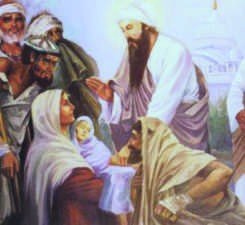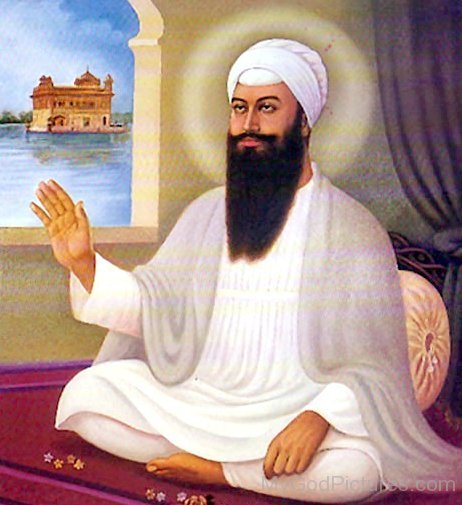Guru Angad Dev, the first successor of Guru Nanak, did yeoman’s work for the evolution of the nascent community. Over a hundred units of Sangat (local congregation of disciples) came to be set up during his pontificate. Langar, the free community kitchen, was organized on an impressive scale. A new script, later to be called Gurmukhi, was updated and popularized, which was also employed to improve the level of public literacy. Seeds of martial spirit were sown by organizing competitions in wrestling and other physical skills among the youth. All these activities were going to determine the evolution of the Sikh community and the Sikh faith.
Guru Angad Dev, known as Lehna before Guruship was born on March 31, 1504, in the village Matte-di-Sarai, now known as Sarai Naga, in the Faridkot District of Punjab. He was a handsome young man. His father, Bhai Pheru, was a trader of comfortable means. His village was plundered during one of Babar’s invasions. As a consequence, the family moved out to Sanghar but eventually settled down in Khadur in district Amritsar.
At his very first meeting with Guru Nanak, Lehna fell under the spell of the enchanting personality of the Guru as well as his captivating civility. He witnessed utter simplicity in a man doing hard labour with his own hands in a field. His living was so humble and unassuming that it could disarm any pride. His profound wisdom and sublime grace bewitched him so much that he simply surrendered to him. That is, perhaps why, he decided to stay with him forever.
Guru Nanak asked him “What is your name dear?”
“Lehna is my name, Master!” (‘Lehna’ in Punjabi means a debt due to a creditor).
“If you are ‘Lehna’, then you have come to the right place to collect the debt due to you,” said the Guru, “and befittingly, like a creditor you came on horseback.” And history testifies that Lehna eventually received from the Guru what he alone was destined to receive.
Although Lehna had decided in his mind never to leave the Guru, Guru Nanak persuaded him to go back to Khadur, share his resolve with his family members, settle any outstanding affairs and return to him if he still so desired. However, Lehna returned as expeditiously as he went, because he could hardly bear the idea of being away from the Guru.
One day, Guru Nanak was working in his fields. At the end of the day, he had gathered bundles of green fodder, which had to be carried for the cattle. The Guru asked his sons to take those bundles home, but they avoided the job saying that this load should be given to a menial to carry. Lehna, however, cheerfully volunteered to carry those heavy and dripping bundles on his head.
When they reached home, the Guru’s wife remonstrated with the Guru, saying, “Why did you give this noble man such a sludgy load to carry? Look at the mud that has dripped over his fine garments.”
“These are not mud spots,” said the Guru, “These are saffron marks of spiritual sovereignty. I chose him for this load because I feel convinced of his ability to carry even much heavier loads.”

Guru Nanak tests Lehna
Several times the Guru put Lehna’s devotion to test. Not that the Guru was unconvinced of his devotion and unexceptionable obedience. Lehna had a firm conviction that obedience signified not servility but freedom – freedom from the strangling clutches of the ego. Lehna had already decimated his ego completely: and
the Guru fully appreciated that. The tests the Guru gave him were meant to demonstrate to one and all that it was Lehna alone who stood supreme amidst them.
One day, the Guru’s bowl fell into a dirty gutter. He asked his sons to take it out. They hesitated, saying, “why not ask a menial to do this job?” However, When the Guru looked at Lehna, he promptly plunged into the gutter and brought out the bowl.
Several other tests of this kind were given and Lehna always acquitted himself giving indisputable evidence of his profound spiritual insight. “I have nowhere else to go”. On one occasion, Guru Nanak assumed a formidable posture. He put on a queer dress and suddenly ran out towards the riverside, carrying a strong and heavy baton in his hands. A whole big crowd of devotees followed his trail. A little later the Guru started throwing out candies from his sling bag. Many of those who were following him started picking up those candies,
but some still continued following the Guru. Having gone a little distance further, the Guru then started wielding his baton and charged the few that still followed him. He hurt some and frightened others. Baba Buddha got injured and so sat down in disgust completely bewildered at the Guru’s strange behavior bordering on insanity. Lehna alone was still following the guru. The Guru then turned back and asked him, “Lehna! Why don’t you also go away?” “Where should I go, Master?” replied Lehna, “I have no one except you.” Guru Nanak said, “I was looking for one to whom I may be able to transfer light. I am happy to have been able to find one in you.”

Nanak appoints Lehna his successor
The Guru was immensely pleased with Lehna and gave him a new name, Angad, meaning, his own limb. He brought him back, gave him a bath, adorned him with fresh set of clothes, and seated him on a pedestal. He sent Baba Buddha to fetch him a coconut fruit and five copper coins. These, he placed before Lehna as an offering and bowed before him in the same manner in which Lehna had always bowed before him. He then asked Buddha to
daub the saffron mark of Guruship on Lehna’s forehead. It was through this symbolic ceremony that Guru Nanak installed Lehna as his successor. Then, Guru Nanak bade the congregation to bow before the new Guru as he himself had done in their presence. According to Mahima Prakash, Guru Nanak then asked Guru Angad if he needed anything. Guru Angad requested him to give him as gift the book of hymns, his waistband and his minstrel. Guru Nanak granted all these with great pleasure. This auspicious event took place on September 2, 1539.
Having become the spiritual successor of Guru Nanak, Lehna came to be known as Guru Angad Dev. Guru Nanak transferred his light, his authority and his spiritual power on to him.
When Guru Nanak had thus established Angad as the next Guru, the village elders came to remonstrate to him for having neglected his own sons in choosing his successor, even though they seemed to deserve equally well. Guru Nanak, however, told them, “They are good human beings but lack the vision which Guru Angad Sahib has.”
The Guru becomes the disciple
Having installed Angad as the new Guru, Nanak took him into his embrace and said, “Whoever reposes faith in you, would be faithful to me: whoever serves you would be rendering me service and whoever considers you different from me, would be distancing himself from the Guru’s grace.” Thereafter, Nanak made it a practice to sit at the feet of Guru Angad as his disciple for as long as he lived. What a reversal of roles between Guru and the disciple!
One day, Baba Buddha asked Guru Angad after the latter had been installed as Guru, “Dear Lehna, when Guru Nanak bowed before you, how did you feel?” “I felt as if a mother has picked up a dirty toddler and made him grow up as big as herself”, replied the Guru.
It has been said that by handing out his blazing torch to Guru Angad, Guru Nanak made it explicit that his faith was an eternally continuing reality.

From Kartarpur to Khadur
Guru Nanak’s sons, however, kept smarting with jealousy and sought every opportunity to create difficulties for Guru Angad. Sensing that, Guru Nanak counseled Guru Angad to shift his headquarters to Khadur, where his wife and children were living and to continue his divine work from there. Guru Angad did go to Khadur, but chose to stay away from public gaze. So he requested
a pious lady, Mai Viraee, who was like an aunt to him, to let him stay undisturbed in her house so that he could meditate and stay in continual spiritual trance. He instructed the lady not to reveal his whereabouts to anyone. However, the devotees in Kartarpur, unaware of his whereabouts, began to miss him with concern. They decided to send a deputation to Khadur to locate the Guru and to enable the Sikhs to see him. The deputing group, consisted of Baba Buddha, Bhai Ajita Randhava, Bhai Sadharan, Bhai Bhagirath and the minstrels. When Mai Viraee came to know of the approaching deputation, she hastily made arrangements for their boarding. Then she went forth some distance to meet them in advance and tell them that the Guru had forbidden her from revealing where he was. At that Baba Buddha said, “Never mind. We shall wail our prayers imploring him to reveal his exalted Being to us. Isn’t that our legitimate right?” He then asked the two minstrels to sing a particular hymn of Guru Nanak so loud that the Guru may hear it wherever he might be.
Hearing this, the Guru could not withhold himself any more. He came out and embraced his loving guests. Angad was Guru for thirteen years (1539 to 1552). With his inimitable humility and spiritual wisdom, he was able to dissolve the schism between his Sikhs and Sri Chand’s followers, who had come to be known as Udasis (renunciates). He preached, as Nanak did, the fatherhood of God and brotherhood of Man without any discrimination.
Popularizing Gurmukhi script
He desired to raise literacy among his followers. Guru Nanak had taught a Sikh, Mehma Khehra, a script improvised by the Guru after updating a locally employed half baked one. This script as updated by Guru Nanak is not only perfectly congenial to Punjabi phonetics, but is also very scientifically arranged. Guru Angad dispatched an emissary to Mehma requesting him to come over to Khadur. He came promptly and at the Guru’s request, gave him the script that Guru Nanak had taught him. Guru Angad improved it further, gave it a more aesthetic aspect and a scientific arrangement on a sound phonetic basis that harmonized with the Punjabi way of speaking. Then, in order to popularize it, he began writing its primers in his own hand to be distributed among children as well as desiring adults.
Janamsakhi and Guru’s Langar
The Guru got a biography (Janamsakhi) of Guru Nanak prepared to get a major contribution from Bhai Bala, a companion of Guru Nanak, and his own memory and that of the other disciples. Bhai Paira Mokha scribed it under the Guru’s instructions. This is considered to have been the first-ever book of Punjabi prose.
Guru Angad organized on a stronger footing and with a more generous prospect the Guru’s free kitchen (Langar). The Guru’s own noble wife, Mata Khivi supervised the Langar. While delicacies were served at the Langar for the Sikhs, the Guru and his family lived on coarse meals, which he earned by selling strings of reed fibre, which he twisted himself to earn his living. He even forbade his sons from even thinking of living on the devotees’ offerings. That, he told them, should be considered poison.
The Guru’s missionary tours
The Guru made two missionary tours to spread the message of Guru Nanak. The first he undertook in 1547 in the Majha tract of Central Punjab and visited Sultanpur Lodhi, Makhu, Harike Pattan, Talwandi Bhai Rode, Panjgirain and Kot Kapura and ended his tour at Matte-di-Sarai, his birth-place. The second was a return tour made the next year through the Malva tract, in which he visited Rautan, Sangatpura, Manuke, Buttar, Lohara, Moga, Gholia, Kot Isse Khan, Harike Pattan and back to Khadur. Wherever he halted, congregations were held every morning and evening. The minstrels sang the Guru’s hymns to these congregations and the Guru gave an exposition of the hymns of Guru Nanak. The Guru also delivered specific sermons to the devotees against superstitious ritualism. He forbade them from observing caste distinctions. On March 20, 1552, the Guru, ignoring his two sons, ceremoniously enthroned Sri Amar Das on the spiritual throne of Guru Nanak and made him Guru Amar Das, the third Guru of the Sikhs. Shortly after that, Guru Angad merged with the divine light.







